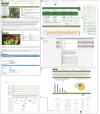PanaxGDB: A Comprehensive Platform for Panax
- PMID: 35693187
- PMCID: PMC9174995
- DOI: 10.3389/fpls.2022.883818
PanaxGDB: A Comprehensive Platform for Panax
Abstract
The genus Panax is a valuable natural medicinal source used worldwide that contains high levels of triterpenoid saponins with extensive pharmacological activities. In past decades, molecular biotechnology and breeding techniques have been respectively used to generate omics data and information on cultivars primarily from Panax ginseng (ginseng), Panax quinquefolium (American ginseng), and Panax notoginseng (Sanqi) to biosynthesize valuable saponins, improve product quality, and conduct cost-controlled cultivation. Although much data have been produced, there are concerns that redundant data might be generated and that relatively scattered data might be overlooked. Therefore, many scientists desire a reliable, comprehensive omics database of the Panax genus that could save time and promote integrated analysis. Therefore, to provide all-inclusive, reliable, and valuable information on the Panax genus, PanaxGDB, an open comprehensive database that integrates data on omics and information on varieties, was established. The database contains information on nearly 600 compounds from 12 Panax species, draft genomic sequences with annotations and gene expression levels, single nucleotide polymorphisms, genome-wide association analysis based on agronomic traits, globally collected germplasm information, summaries, omics data of the Panax genus, and online versatile analytic tools. The Panax genus database will be updated when new data are released to continue serving as a central portal to boost research on the biology and functions of Panax. PanaxGDB is available at: http://panaxGDB.ynau.edu.cn.
Keywords: Panax; cultivars; database; genome; saponins.
Copyright © 2022 Lin, Hao, Lu, Dong, Li, Zhang, Yang, Xiang, Liu, Li, Zhu, Yang, Li and Yang.
Conflict of interest statement
The authors declare that the research was conducted in the absence of any commercial or financial relationships that could be construed as a potential conflict of interest.
Figures



References
-
- Beedata (2020). Report on Data Analysis of China's Sanqi Industries in 2020. Available online at: https://finance.sina.com.cn/money/future/agri/2020-10-16/doc-iiznezxr636... (accessed December 24, 2021).
LinkOut - more resources
Full Text Sources
Miscellaneous

